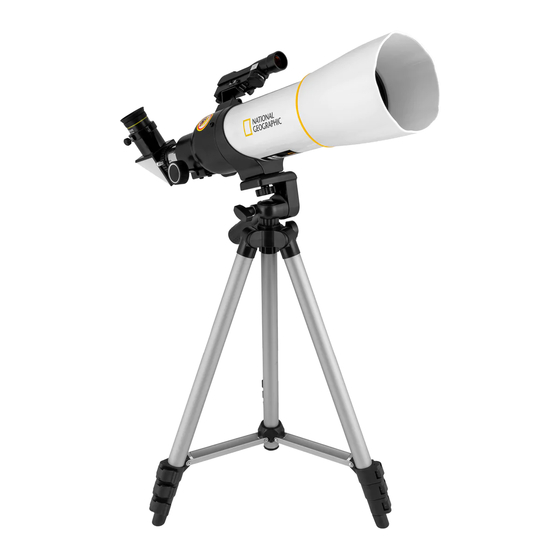Advertisement
Quick Links
RT70 40 0
70 MM R EFL ECTOR T EL ESCO PE
W/ PA N H A N D L E M OUNT
IN ST RU C T I O N M A NUAL
WARNING:
SUN HAZARD — Never look directly at the sun
with this device.
WARNING:
CHOKING HAZARD — Small parts.
Not for children under 3 years.
1
X
CR2032
3V
INCLUDED
WARNING:
Contains button or coin cell battery.
Hazardous if swallowed — see instructions.
1
WARNING:
The lens contains lead that may be harmful.
Wash hands after touching.
WARNING:
This product can expose you to chemicals including lead,
which is known to the State of California to cause cancer.
For more information go to www.P65Warnings.ca.gov.
1 0+
80- 50070
E N
Advertisement

Summary of Contents for National Geographic RT70400
- Page 1 1 0+ 80- 50070 RT70 40 0 70 MM R EFL ECTOR T EL ESCO PE W/ PA N H A N D L E M OUNT IN ST RU C T I O N M A NUAL WARNING: WARNING: SUN HAZARD —...
-
Page 2: Important Safety Instructions
Customer Service: Call 1-866-252-3811 READ AND FOLLOW THE INSTRUCTIONS BEFORE USE. IMPORTANT SAFETY INSTRUCTIONS KEEP THESE INSTRUCTIONS FOR LATER USE. • SUN WARNING: WARNING: NEVER ATTEMPT TO OBSERVE THE SUN WITH THIS DEVICE! OBSERVING THE SUN – EVEN FOR A MOMENT – WILL CAUSE INSTANT AND IRREVERSIBLE DAMAGE TO YOUR EYE OR EVEN BLINDNESS. - Page 3 What’s Included: *phone not included Parts Overview 1. 70 mm Telescope 2. Optical Tub Assembly (OTA) 3. Red Dot Viewfinder Available Downloads Visit: 4. Focuser www.esmanuals.com 5. Diagonal 6. Focus Wheel 7. Panhandle Alt-Azimuth Mount 8. 1.25” 20 mm & 10 mm Kellner Eyepieces 9.
- Page 4 Assembly: Note: We recommend assembling your telescope for the first time in the daylight or in a lit room so that you can familiarize yourself with assembly steps and all components. • Open the tripod on a stable surface until the tripod spreaders are fully extended. •...
-
Page 5: Troubleshooting Guide
Cleaning: Your telescope is a precision optical device and keeping the optics free of dust and dirt is crucial for optimal performance. To clean the lenses (objective and eyepiece) use only a photo-grade soft brush or a lint-free cloth, like a microfiber cloth. Do not press down too hard while cleaning, as this might scratch the lens. - Page 6 Using The Smartphone Adapter: SUPERVISION BY ADULTS Read and follow the instructions, safety rules and first aid information The Smartphone Adapter will allow you to connect almost any “smart” device to an eyepiece. To use the adapter, place it directly onto the selected eyepiece and secure it by tightening the set screw until snug.
- Page 7 Notes:...
- Page 8 Observing Tips: Star hopping Star hopping is a technique used by amateur astronomers to navigate the night sky. By using easily recognizable constellations and asterisms as a guide, an observer can locate stars and other objects. For example, Polaris, which is Merak Dubhe commonly referred to as The...
- Page 9 Pleiades Star Cluster(M45): Right ascension: 03: 47.0 (hours: minutes) Declination: +24: 07 (degrees: minutes) Distance: Approximately 444 light years The Pleiades Star Cluster is a group of brilliant blue stars located in the Taurus Constellation. Also known as Messier 45 or “Seven Sisters”, this open star cluster consists of more than 1,000 confirmed stars, although an average of only six are visible to the unaided eye.
- Page 10 Types Of Telescopes: Focuser Light Primary Mirror Secondary Mirror (Objective) Light Reflector A reflector telescope uses mirrors to gather and focus light. Light enters the telescope through its open front end and travels to the concave primary mirror at the back. From there the light is reflected back up the tube to a flat secondary mirror, which sits at a 45°...
- Page 11 Telescope Terms to Know: Focal Length Objective Lens Eyepiece Eyepiece (mm) Focuser Aperture (mm) Diagonal Focal Point Focal Length Telescope (mm) Focal Length Eyepiece Eyepiece (mm) Focuser Focal Point Aperture Primary Mirror Secondary (mm) (Objective) Mirror Focal Length Telescope (mm) Aperture: This figure, which is usually expressed in millimeters, is the diameter of a telescope’s light-gathering surface (objective lens in a refractor or primary mirror in a reflector).
- Page 12 Aperture 102mm Eyepiece Focal Length 20mm Telescope Focal Length Magnification: 1000mm The magnification corresponds to the difference between observation with the naked eye and observation through a magnifying device like a telescope. If a telescope configuration has a magnification of 30x, then an object viewed through the telescope will appear 30 times larger than it would with the naked eye.
- Page 13 Short Eye Relief Distance Long Eye Relief Distance Eyepiece Lens Eyepiece Lens Eye Relief Eye relief is all about a comfortable viewing experience because it is the distance at which you need to position your eye from the eyepiece’s outermost surface to enjoy the full field of view. This characteristic is of special concern to observers who wear glasses to correct an astigmatism, because a long enough eye relief is necessary to allow room for glasses.
- Page 14 ©2021 National Geographic Partners LLC. All rights reserved. NATIONAL GEOGRAPHIC and Yellow Border Design are trademarks of the National Geographic Society, used under license. ©2021 Explore Scientific, LLC 1010 S. 48th Street, Springdale AR 72762. All rights reserved. Made in China.
















Need help?
Do you have a question about the RT70400 and is the answer not in the manual?
Questions and answers